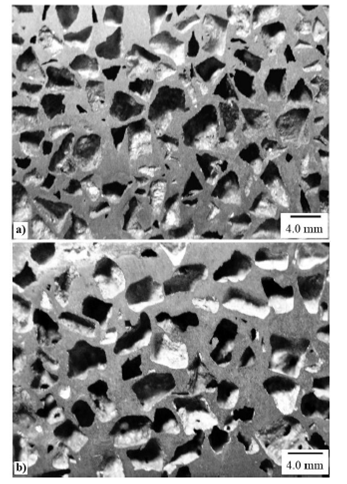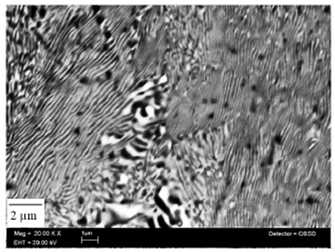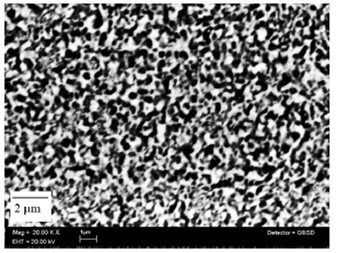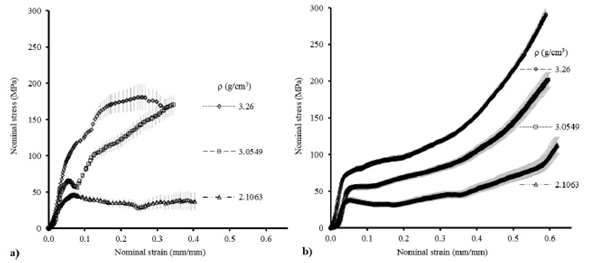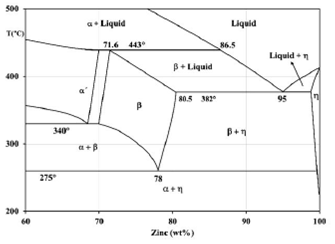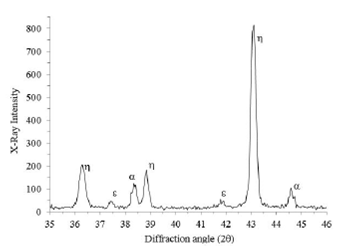1.Introduction
Cellular metals are a matrix with many voids or cells and are called foams when their cells are not interconnected or sponges when they are connected, as stablished by Ashby and Medalist 1.
These materials have drawn the interest of researchers, and engineers because of their diverse properties that support their multifunctional potential, as documented in an important and complete handbook of cellular metals written by Degischer and Kriszt 2.
More specifically, a piece of a cellular metal can be used for filters, noise or vibration dampeners, heat exchangers, packaging of fragile objects, catalysis support and in structures because low weights and adequate mechanical strength are achieved. In addition, the properties of cellular metals could be further modified if the metal is a two-phase alloy whose microstructure changes with heat treatment, which increases its possible applications.
The Zn22Al alloy foam was already elaborated using the melt foaming method and CaCO3 as blowing agent to determine its compressive properties 3 and dynamic compressive strength 4. This foam was as well processed with titanium hydride (TiH2) as a blowing agent to find the effect of porosity on tensile and compressive deformation 5.
The Zn22Al foam was additionally produced with short Al2O3 fibers 6 or SiC 7 as stabilizing agents and reinforcement to assess the effect of these ceramics on compressive properties or compressive properties and damping, respectively. Moreover, the Zn22Al alloy was made like composite foam to stablish the effect of different SiC contents on its compressive properties 8.
Open cell Zn22Al foams 9 and Zn22Al-1Cu foams with different microstructures 10, gotten by applying heat treatments, were produced by using preforms of NaCl and the process of replication to subsequently obtain the behavior and absorption capacity of energy under compression.
A study about closed-cell Zn-22Al foams was made using the powder metallurgy process, and its mechanical strain rate sensitivity was determined 11. Moreover, a new composite-syntactic foam with different volume fractions (6-50 vol. %) of fly ash micro balloons coated with Ni, as the space holder material, was elaborated by the stir casting (vortex). Then, the effect of the ash volume fraction on microstructure, properties of compression and sensitivity of strain rate were determined for this material 12.
In addition, solid borosilicate glass spheres-Zn22Al2Cu composites were already elaborated and analyzed under compression as a function of their density and type of microstructure in the alloy matrix 13. This material behaved similarly to cellular metals, but with collapse stresses (122.4-230.9 MPa) and plateau stresses (70-210 MPa) greater than those of conventional cellular metals (∼8−16 MPa) 14. This study provides, additionally, a new and simple method with high potential for the development of metal matrix composite materials with cellular behavior.
There are several methods to produce cellular metals: Nakajima 15 described the elaboration, properties and uses of metals with directional pores and Banhart 16 revised the manufacturing routes for metallic foams. One of these processes is to use granules or preforms of NaCl, which are embedded in the metal matrix and subsequently dissolved to form the cells.
For example, Yu et al. 9 used this method to elaborate open-cell Zn22Al foams, which they after mechanically characterized. Casolco et al. 17 manufactured close-cell Zn foams, and they followed the evolution of these foams. He-fa et al. 18 as well produced Al foams, which they later mechanically characterized, and Jian-Ning et al. 19 made a study on preparation of Zn-Al eutectoid alloy foamed by the infiltration process with air pressure and employed NaCl. NaCl granules used in all these studies were irregular or cubic in shape.
In this study, the Zn22Al2Cu cellular alloy was processed with six different densities; it was separately used granules with sharp and smoothed edges as spacers, and the as-cast and fine-grained microstructure in the matrix. It is desired to stablish how these parameters affect the compressive behavior of this alloy foam, and if this behavior is similar to that shown by the most cellular materials, following simple equations derived from the more known mechanical models for cellular metals.
2.Experimental
2.1.Alloy processing
The Zn22Al2Cu alloy was produced at 700 by conventional casting using Zn, Al and Cu ingots with 99.99%, 99.27% and 99.999% purity, respectively. Appropriate amounts of the elements were weighed in a Mettler H45 precision balance (10-4g). A total quantity of approximately 5 kg of alloy was elaborated.
A graphite crucible and a muffle type oven were used for the casting. The density of this alloy was 5.4 g cm-3 and was obtained using the Archimedes method.
2.2.NaCl granules and smoothing their shape
The NaCl used was natural and in the form of granules with irregular shapes, hereinafter referred to as granules with sharp shapes, and varied sizes. Its physical characteristics are a Young’s modulus of approximately 40 GPa, melting temperature of 816 and density of 2.16 g cm-3.
Portions of the granules were sieved to obtain enough granules with sharp shapes and an average size of 4 mm. Other portions of granules of 200 g each, with an average size greater than 4 mm, were smoothed separately in a rotary device, which was designed and built for such purpose, having a rotatory cylindrical container with a sandpaper number 80 placed on its internal sidewall and base.
It was used an angular velocity of 65 to 75 rev⋅min-1 for 2 hours in each operation to smooth NaCl grain shape. Smoothing the granules causes them to fit better together and fill the spaces. Subsequently, these grains were sieved to select those with an average size of 4 mm.
2.3.Preparation of cellular alloy with different density
The cellular alloy with different density was obtained by first preparing composite materials with the Zn22Al2Cu alloy and NaCl granules. Each composite was prepared with 800 g of alloy and with a different portion of the salt granules to obtain composites with different densities: several of these portions had granules with sharp shapes, and other amounts of NaCl were granules with smoothed shapes. The composites were afterwards put in boiling water to dissolve the salt.
Each composite was prepared by melting and keeping the 800 g of alloy at 700 and separately preheating the granules at 400. Subsequently, the heated granules were added to the melted alloy, and finally, each suspension was air-cooled: the granules were pushed into the liquid metal with a piston to prevent them from floating for an appropriate amount of time (suspensions obtained were not stirred) until the semisolid metal viscosity was sufficient, because more and more metal solidified as the cooling went on in the air, so that the granules were trapped inside the metal.
Every composite material was cut into two equal parts. One of them was heat treated, as described in 2.5, to change the microstructure in its metallic matrix.
The pieces of composite with different microstructures were submerged separately in boiling water for 20 minutes to dissolve the salt and then dried with a cloth and warm air. Later, the densities of cellular alloy pieces obtained were determined.
2.4.Density calculation
The densities of the cellular alloy obtained were determined by calculating the mass/volume ratio of samples with dimensions of 3.0 x 3.0 x 6.0 cm3. They were obtained using a high-speed cutting wheel. The measurements of the dimensions were made within 0.001 cm precision. The mass of each sample was measured with a precision of 0.0001 g on a Mettler analytical balance.
It was obtained densities of 1.9592, 2.4592 and 3.0339 g cm3 and 2.1063, 3.0549 and 3.2600 g cm3 when the shape of the cells in the alloy matrix was sharp and smooth, respectively.
2.5.Matrix microstructures
The first matrix microstructure, called the as-cast microstructure, was obtained during air-cooling in the last stage of elaboration of the composites. The other microstructure was induced by a heat treatment in which the composite with the as-cast microstructure were heated and maintained at 350 for 45.5 hours and quenched afterwards in acetone cooled at a 0 temperature.
To visualize and characterize the microstructure of the alloy foams, samples of each microstructure were polished with a diamond suspension to get a scrapes free sample surface, and then that surface was chemically treated in C2H6O with 1% of HNO3. Microstructures were characterized with a Leica Cambridge scanning electron microscope. Several zones were photographed and compositional analysis by EDXS was made in different microstructural constituents.
2.6.Compression testing
Compression test and parameters of the obtained curves were realized and extracted following the ISO 13314: 2011 standard.
Samples had dimensions of 3.0 x 3.0 x 6.0 cm3 and were tested under compression at a 10-3 s-1 strain rate in an Instron testing machine.
All samples were photographed before (Fig.1) and after compression with an Olympus digital camera.
3.Theory
The compressive curve characteristic of cellular materials is formed by three zones: a first zone, called the elastic zone, where stress fluctuates linearly with strain, which finishes in a stress peak (named yielding point or collapse stress). A second zone, where stress varies slightly around a central stress value, called plateau stress, and a last zone, where stress increases substantially as strain increment, which is associated with the consolidation of cellular metals 20: it is recognized that level of this curve increases as density enhances.
Because the properties of a cellular metal are affected to a greater or lesser extent by the shape, size, quantity and distribution of its cells, the cells could be considered as a “structural component”, even though these are void spaces and, consequently, consider the cellular metal as a type of “composite material”. Then, the rule of mixtures given by Eq.(1), originally developed for composite, could be applied to cellular materials,
where ρ is the density, cm is the cellular metal, ce is the cells, m is the metallic matrix and X is the volume fraction.
But because there is not material inside the cells,
Considering also that it is always true that
where
Additionally, Ashby and Medalist 1
report that the elastic modulus of cellular metals in relation to that of the
matrix,
where C1 is a constant, α = 2 if the cells are not isolated (sponges), and α = 3 when the cells is isolated (foams).
Ashby and Medalist 1 also state that the collapse and plateau stresses of cellular metals, respect to the yielding stress of the matrix, ym, vary with the relative density, in according to
where C2 is constant.
4.Results
The two images in Fig.1 show that most of the cells were clearly isolated (closed) on the surfaces resulting from the cut. Therefore, the correct name of the materials could be foams. However, when the compression test samples were observed under a nearby light source, the light crossed from one side of the compression test samples to another opposite side because they had a set of interconnected internal and external cells. So cell structures of samples were a combination of open and close cells. Hereinafter the terms alloy foam or alloy foams will be used to refer to the material or materials studied.
4.1.Densities
Table I shows the absolute densities, relative densities, volume fraction and percentage of cells with both shape type obtained for the alloy foams; the table also shows the density assigned and obtained to the cells and the matrix, respectively. The volume fraction of cells was calculated using Eq.(3) in Sec.3.
Table I Absolute and relative densities, volume fraction and percentages of cells of the alloy foam with cells with both shape types, and densities of the matrix and cells.
| Alloy foam with cells with | |||||||||
| Sharp shapes | Smooth shapes | Matrz | Cells | ||||||
| ρAF | ρr = ρAF /ρm | Xce | %vol. | ρAF | ρr = ρAF /ρm | Xce | %vol. | ρm | ρce |
| 1.9592 | 0.3628 | 0.6372 | 63.72 | 2.1063 | 0.3900 | 0.6100 | 61.00 | 5.4 | 0 |
| 2.4592 | 0.4554 | 0.5446 | 54.46 | 3.0549 | 0.5657 | 0.4343 | 43.43 | 5.4 | 0 |
| 3.0339 | 0.5618 | 0.4382 | 43.82 | 3.2600 | 0.6037 | 0.3963 | 39.63 | 5.4 | 0 |
4.2.As-cast microstructure
Figure 2 shows a representative area of the casting matrix microstructure of one half of the alloy foams studied.
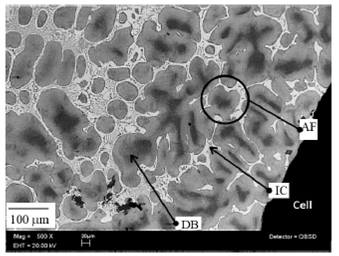
Figure 2 Representative area of the as-cast matrix microstructure of one half of the alloy foams elaborated. DB, dendritic branch; IC, inter-dendritic component, AF, area with fenced.
Figure 2 clearly shows the presence of dendritic branches, an inter-dendritic component and aspects that appear to be fenced areas with dark gray centers and light gray edges.
Dendrites and inter-dendritic component have a substructure of two components or alternating phases, one dark and one clear, that can be seen better at high magnifications, as in Fig. 3, which shows the dendritic substructure.
4.3.Thermally induced microstructure
Figure 4 shows a representative zone of the thermally induced microstructure in matrix of one half of the alloy foams investigated.
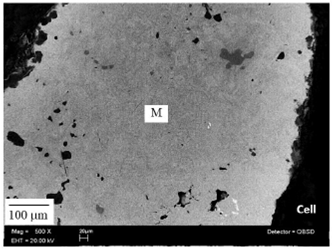
Figure 4 Representative area of the thermally induced microstructure in matrix, M, of one half of the alloy foams studied.
At low magnifications, the matrices can be observed as large gray areas with some tiny black and light embedded islands. When the magnification is increased, a fine sub-microstructure was observed, as shown in Fig. 5. The walls of the cells did not have cracks.
4.4.Compression tests
Figures 6 and 7 show the curves of the nominal stress versus nominal strain of the alloy foam for the three densities achieved with cells with sharp and smooth shapes and with as-cast and fine-grained matrix microstructures, respectively.
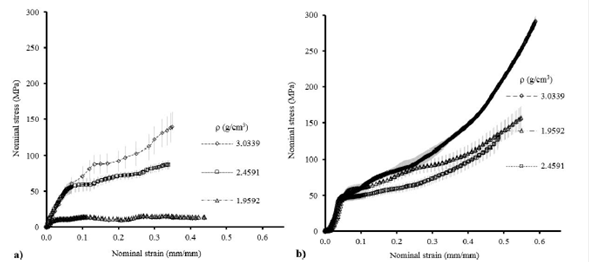
Figure 6 Nominal compressive stress as a function of nominal strain, for each density value and microstructure, a) as-cast and b) fine, of the matrix with sharp shapes cells.
5.Discussion
5.1.Densities
Table I clearly shows that the densities are in the lower range; therefore, the vol. % of cells is in the higher range when cells have sharp shapes.
5.2.As-cast microstructure
Compositional analysis by EDXS exposed that the dark centers of dendrites are Al rich; the two alternated bright and dark tonality constituents forming the inter-dendritic component and the substructure of dendrites are Al and Zn rich phases.
Fenced regions were formed in the casting microstructure because the peritectic transformation, at 72 wt.% Zn and 443, see Fig. 8, was incompletely verified due to non-equilibrium conditions existent during cooling of the last stage of the composites elaboration process. Al and Zn-rich alternated sheets are α and β terminal phases, respectively.
These phases integrated the substructures of dendritic branches and the inter-dendritic component. The first substructure was formed via the eutectoid transformation, at 78 wt.% Zn and 275; the other substructure was created by an eutectic transformation at 95 wt.% Zn and 382 (see Fig.8).
5.3.Thermally induced microstructure
The fine-microstructure in the matrix was created by a beta-phase transformation that occurs in the Al-Zn system when eutectoid alloy is fast cooling from a temperature above 275. Sandoval-Jimenez et al. 22 report that a two stages transformation occurs: at the first stage, triclinic β phase, just after the alloy is fast cooled, transforms to a hcp η phase plus a second rhombohedral phase; the second stage: rhombohedral phase additionally changes to hcp η phase plus fcc α phase.
Figure 9 shows an x-ray diffraction pattern
of the matrix alloy with fine microstructure of foams studied: α and η are
equilibrium phases of the Zn-Al alloy system, see Fig. 8, and
Cell walls with fine microstructure were not cracked, probably because the deformation of the NaCl granules used as the spacer material mitigated the contraction of the matrix when it solidified and during the quenching of the alloy-NaCl granules composite in the last stage of its preparation and of the heat treatment applied.
5.4.Compression tests
The comparison of the compression curves obtained show that the alloy foam with
smooth shapes cells, fine matrix microstructure and lowest density, as presented
at the bottom of Fig. 7b, has the
More specifically, such curve has an initial zone of elastic deformation with linear variation between stress and strain, followed by a maximum or yield stress, called collapse stress. Next, there is a zone where the stress fluctuates slightly around a central value, which defines a type of plateau and, finally, a zone in which the stress continuously and substantially increases as strain increases, known as the consolidation region of the material.
As the density of the alloy foam with fine microstructure and cells with smooth shapes increases, the elastic modulus increases continuously and slightly (see Fig. 11a). The collapse stress tends to vanish: it is first observed as a maximum of stress and it transforms toward a point of inflection (see Fig. 7b), and its value increases progressively and slightly (see Fig. 11b). In addition, the density increase causes the plateau of stresses to occur at increasingly higher values and to decrease in extension until it almost disappears; it also causes the last densification region to start at increasingly higher stress values and lower strain values and the curve level increases substantially in these last two regions, as illustrated in Fig. 7b. This compression behavior becomes evident because the cells have a smoothed shape, and this is due to diminishing of cells number when foam density increases.
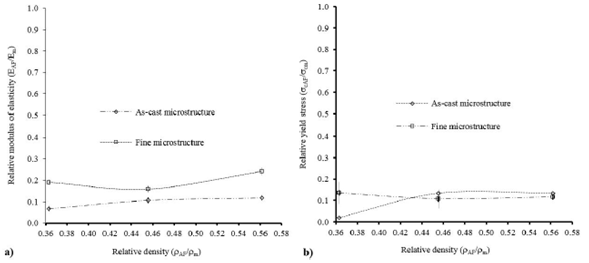
Figure 10 a) Relative modulus of elasticity and b) Relative yield (or collapse) stress versus the relative density of alloy foam with sharp edges cells and for as-cast and fine microstructures.
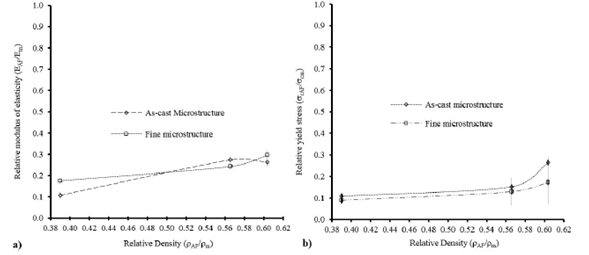
Figure 11 a) Relative modulus of elasticity and b) Relative yield (or collapse) stress versus the relative density of alloy foam with smooth shapes cells and for as-cast and fine microstructures.
If the fine microstructure is maintained and it has cells with sharp shapes instead of smooth shapes, the compressive behavior is chaotic and different from the above case (associated with cellular materials under compression and reported in the literature), as shown in Fig. 6b. Thus, the modulus of elasticity, shown in Fig. 10a, and collapse (or yield) stress shown in Fig. 10b, first decrease and then increase as density increases. No plateau can be seen in Fig. 6b, and the curve level does not increase as density does. The curves are very close for the two lowest density values; consequently, the last two regions of the curve of the alloy foam with higher density are slightly higher. Thus, it is believed that this compressive behavior is caused by the stress concentrations in the cell walls caused by the sharp edges of these same cells.
On the other hand, if the matrix microstructure is as-cast instead of fine and
regardless of the shape of the cells, the compression curve of the lowest
density alloy foam ends in a plateau and does not have a densification region,
Fig. 6a and 7a. This is the case at least until an approximate strain
value of
In contrast, with the alloys with fine microstructure and smooth cells, as their
density increases, their densification starts approximately at
In addition, increasing the density of the alloy foam with the as-cast matrix microstructure causes a steady increase in the relative elastic modulus and relative collapse stress (see Fig. 11a and 11b) or an initial increase, and then, these two parameters remain constant, (see Fig. 10a and 10b), when the cells have sharp or smooth shapes, respectively.
At the same time, when the density increases, the plateau disappears, and the plastic zone level of the curves increases regardless of the shape of the cells, when alloy matrix has an as-cast microstructure, as shown in Fig. 6a and 7a. Then, it is evident that as-cast microstructure is less sensible to shape of cells than fine-grained microstructure is.
Florek 23 reports in his work on aluminum foams that certain characteristics of their compression curves indicate whether an aluminum foam has brittle or ductile behavior: a curve of a ductile aluminum foam has three characteristic zones (one of linear elasticity, another with a plateau and a final zone of consolidation), the first two zones are separated by an almost imperceptible collapse stress, followed by a plateau with a non-zero slope and a short extent (compared to a plateau in a compression curve of brittle aluminum foam) and the whole curve is smooth, without bulges (similar to the compression curve of cork 24), whereas the curve of a brittle foam has a clear collapse stress, and if this stress is followed by a sharp drop a plateau may not be present on the curve, but if the compression curve has a plateau, it is extensive and has ripples. So, based on what is written here and in previous paragraphs, foams studied with fine microstructure have a behavior similar to that of ductile aluminum foams, while the foams with casting microstructure behave like brittle aluminum foams.
In a previous work carried out by the authors of this work, using the same alloy matrix and microstructures but with embedded solid glass spheres 13, it was established in compression that the dendrites in as-casting microstructure are plastically deformed and micro-cracks are created, mainly in the inter-dendritic component. This makes the stress acting against the spheres is low when compression stresses are applied. While the tiny constituents of the fine microstructure are not deformed because they do not contain dislocations, as it was stablished by Torres et al. 25 when they exposed the properties and uses of the Zn22Al2Cu alloy, and, therefore, the stress is communicated almost directly from grain to grain and against the spheres. The authors of this work think that the same phenomena could be too happening when the structural component is void spaces instead of glass spheres.
Then, it is possible that the stress concentrations produced by sharp edges, McClintock and Argon 26 prove that the holes or particles with sharp shape edges are the most severe stresses intensifiers, of cells were not attenuated because the local plastic deformation was null or too low at the tip of such cell edges, in the fine microstructure. Therefore, it is possible that sharp edges provoked the micro-cracks formation and fragility of alloy foam, Felbeck and Atkinsthe 27 explain well about this in their book about strength and fracture of engineering solids, when the stress was applied. Therefore, it results a compression behavior more sensitive to cell shape change when the microstructure is fine.
At the end of the first paragraph of Sec. 3, it is written that the level of a compression curve increases in the order that foam density enhances. This variation pattern is observed in graphs of Fig. 6a, 7a y 7b, but not in graph of 6b: because the curve of alloy foam with an intermediate density value has the lowest level. This anomalous behavior is due both to the response of fine microstructure of matrix and the effect caused by the sharp cell shape when compression stresses are applied.
The least squares method is used to establish how well the (
Additionally, values of 0.8604, 2.1819 and 0.9674 were obtained for C, n and R2, respectively, for the material with as-cast microstructure and cells with smooth shapes; C = 0.4851, n = 1.0911 and R2 = 0.9426 were obtained for the material with the same cell shape (smooth) and fine microstructure.
In addition, the same fitting method was used on the data (
Values of C = 2.1111, n = 4.2441 and R2 = 0.7695 were calculated for the material with as-cast microstructure and cells with sharp shapes; for the material with the same cell shape and fine microstructure, the values established were: C = 0.09, n = -0.358 and R2 = 0.4453.
Moreover, values of C = 0.50, n = 1.6706 and R2 0 0.748 were calculated for the material with as-cast microstructure and cells with smooth shapes; C = 0.3084, n = 1.3365 and R2 = 0.9028 were calculated for the material with the same cell shape and fine microstructure.
Thus, considering the correlation indexes (R2) obtained, the only
alloy foam that satisfies the Ashby equation between the relative modulus of
elasticity and relative density of sponges is that with as-cast microstructure
and cells with smooth shapes, following the relationship:
In turn, the alloy foam with fine microstructure and cells with smooth shapes
satisfies a near-linear dependence equation between the relative modulus of
elasticity and relative density. This equation is similar to that deduced from
the general model for these parameters of mechanical behavior under compressive
stresses of foams when materials have very low densities, as deduced by Avalle
et al 28, or relative
densities lower than 0.1. More specifically, it satisfies the following
equation:
The different functional relationship found between the relative elastic modulus and the relative density (quadratic type when the alloy matrix has a cast microstructure, and linear, when it is fine) if the cells embedded in the alloy has smoothed shape, could be explained according to the participation degree of the cells in the matrix when compression is applied.
It is known that the fine microstructure is formed by dislocation free constituents 25 and therefore they do not deform, so the compressive stress is almost completely transmitted against the cells. This causes that cells determine more the elastic behavior of this microstructure, as it happens with foams have a very low density 29, because they have a large number of cells, and it is more common to find a linear relation between their relative elastic modulus and relative density.
Then, in summary, the smooth shape of the cells causes a more normal compressive behavior that allows the effect of changes in the matrix microstructure to be clearly distinguished. When alloy matrix has an as-cast microstructure, an elastic behavior is generated in compression as a function of density, similar to that of most sponges. This behavior follows an equation proposed by Ashby for sponges under compression stresses. The fine microstructure induces, in general, a compressive behavior with a higher elastic modulus than those obtained with the as-cast microstructure; this elastic behavior satisfies a linear equation between stress and strain like the foams with densities much lower than foams studied with fine microstructure matrix in this work.
In contrast, the compressive behavior of the Zn22Al2Cu alloy foam with cells with sharp shapes and regardless of its matrix microstructure does not follow any Ashby equations for cellular materials. This may be the result of both the sharp shape and the large size of the 4 mm cells. This partially matches with that reported for the Zn22Al alloy sponge 9 prepared using the replication process and 0.84-3.9 mm NaCl granules and tested in compression, because it is only reported that their relative collapse stress varies with the relative density as predicted by the Ashby model, given by (5) in Sec. 3.
Table II shows data obtained for the alloy foams analyzed in this study and for the materials made with the Zn22Al alloy in other studies. With this information, it can be inferred that in general, the alloy foams made in this study with as-cast or fine microstructure have greater energy absorption capacity and higher compression strength values than Zn22Al foams with SiC particles or those with 1.0 Cu and 0.03 Mg. However, these parameters are lower than the same parameters founded for Zn22Al syntactic foam composites.
Table II Comparison of the data obtained for the alloy foam in this study and the information found for materials made from a Zn22Al alloy in other studies.
| Matrix | Material | Matrix Microstructure | Energy absorption capacity (MJ/m -3 ) | Compressive strength (MPa) | Densities ratio (p AF =p M ) | Process | Reference |
| Zn22Al2Cu | Alloy foam with cells with sharp shapes | As-cast Fine | 4.01 to 27.77 a 17.87 to 24.12 a | 8 to 49*¤ 42 to 53** | 0.3628 to 0.5618 | Alloy melting, granule | This study |
| Zn22Al2Cu | Alloy foam with cells with smooth shapes | As-cast Fine | 11.14 to 46.5 a 11.06 to 29.74 a | 39 to 96*¤ 35 to 67* | 0.39 to 0.604 | Immersion and air-cooling | |
| Zn22Al | Composites-foams with SiC particles | As-cast | 0.96 to 1.18 a | ~3:5 to 4.64*** | 0.177 to 0.186 | Stir-casting | 8 |
| Zn22Al with 1.0 Cu and 0.03 Mg | Open cell foams | As-cast | 3 to 7.5 a | 4.7 to 20*** | 0.279 to 0.396 | Replication with NaCl preforms | 9 |
| Zn22Al | Composites of syntactic foam with fly ash micro balloons coated with Ni | Fined-grained | 55 to 133 b | 75 to 200** | 0.623 to 0.962 | Stir-casting | 12 |
a ε= 0.34; b ε = 0.60 and strain rate of 8.3 x 10-4 s-1; *Yield or collapse stress, **First maximum stress; ***Collapse stress; ρ is the density; AF is the alloy foam or syntactic foam.
6. Conclusions
In general, the compression curves of the Zn22Al2Cu alloy foam having the lowest densities are typical of this type of material. The compression curves are at a higher level and/or are more separated from each other as the density increases if the cell shapes are smooth. This shape of the cells in as-cast microstructure in the matrix produces a behavior of elasticity in alloy foam during compression, which is described by the equation derived by Ashby for the relative modulus of elasticity and relative density of sponges. At the same time, that same type of shape in the cells embedded in fine microstructure creates an elastic behavior in compression as a function on density, which is typical of foams with very low relative densities, lower than 0.1, that is much lower than densities achieved in this work. Compressive behavior is chaotic and the effects of changing microstructure and density are difficult to identify when cell are sharp, regardless microstructure in matrix, being this more evident when matrix alloy has a fine microstructure. Foams with as cast or fine matrix microstructure have a compression behavior similar to fragile or ductile aluminum foams, respectively. The alloy studied with 4 mm mean size cells has a compression behavior like a sponge or low-density foam, when its cell walls have smooth contours, and as-cast or fine microstructure, respectively.











 nueva página del texto (beta)
nueva página del texto (beta)

